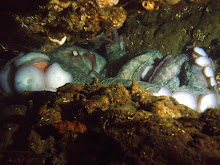
Let me answer the last question first. By no means is technical diving an out and out competition with men. This is not a statement of "I can do anything you can do better". Nothing could be farther from the starting point than that statement. I have attributes that make me a better technical diver than some and a learning curve that makes me competitive with others. I think you have to realize we are all learning, working to push our individual limits under the guides of understanding diving discipline, depending on your buddy for support and guidance and perpetually diving to apply learned techniques and knowledge. After all, the corner stone of the DSAT program is that we teach redundancy in equipment and teamwork as divers. Two brains are better than one.
Am I competitive? Most definitely! In everything I do I play to win. With technical diving my competition is individual, I want to push my individual limits, but at my pace, and only when I am ready for the additional responsibilities of deep technical diving, greater depths, and overhead environments. But, I too am having a lot of fun learning and experiencing.
Technical diving is not a guy or a girl thing...it is a technical diver thing.
That being said, I also know that developing as a technical diver means you have to dive. I am pretty fortunate in that regard as I get to dive on a regular basis. After all, to be good at diving you have to get into the water. Structured education is the corner stone to developing as a technical diver. As a DSAT TecDeep Instructor and DSAT Tec Gas Blender Instructor, I have had the opportunity to work with a wide array of divers with various talents. Education, whether it is obtained through practical applications, textbook learning and or research projects is absolutely priceless. You really need to be able to understand all aspects of technical diving. Gear configuration, gas management, diving physiology, and most importantly decompression theory and procedures are just some of the basics of technical diving.
Is the equipment heavy? No way around that math problem, yes it is, sometimes very heavy. But that is generally from the back of the truck to the beach, or from the dive rack to the dive door on the boat. Once in the water this type of equipment is no more difficult to move and manipulate than most dive equipment configurations. Certainly no more difficult than my rebreather.
In fact I enjoy diving my twin tanks (I dive high pressure 100's) as much, if not more than diving a single tank. I tried the high pressure 80's, but found them to be very difficult to set down and pick up on the boat or in back of the truck due to the short bottle. Deco bottles can be added after you have entered the water from the beach. I really like leaving the boat with all my toys in place. When I enter the water off of a Bandito boat or from Kal's skiff in Sechelt I really like to have all of my toys with me. At the end of the dive, team members from these outstanding dive charters are always there to help me out. Climbing the ladder with a set of twin tanks most assuredly will make your knees wobble. But then again it is only a few steps and Rick or Kal or a crew member are right there to help. To answer in a nut shell, yes the equipment is heavier, but it is so cool to be able to do this type of diving.
Let me see if I can give you a vivid example of what I am talking about. Last year we did a 215 foot dive off of the Pine Trees in Kona, Hawaii. Ken Pfau, Terry and myself entered the water with our deco bottles. We were on a relatively small boat so opted to enter the water one at a time. We did our bubble safety checks and then left the mooring ball behind in 20 feet of water and began swimming down to our depth. Out past the shallow reef and over the ledge.
We were amazed that the bottom dropped away as radically as it did. On this dive we were treated with the experience of diving with a school of nearly 100 False Moorish Idols, we found a pink coral tree and we saw healthy vibrant coral all the way down to 215 feet. To me it was almost immediately evident when we left the area of 100 feet, that divers had not been in this area before. It felt like we were the first divers to visit this depth at this location. The fish weren't concerned, we saw a lot of fish faces, vegetation appeared healthy and undisturbed, and we were exploring.
We completed our dive of 215/20 minutes and began our ascent to the surface. A little over an hour and a half after we left the mooring ball we returned to the surface. This was a wonderful dive full of memories and experiences. I could not have completed this dive without proper training, perpetual diving, and of course disciplined dive buddies.
We all agree training is the key to survival. And when we dive at these depths we dive as our lives depend upon it. Our equipment is maintained, we train often, and we share all aspects of planning these types of dives. We are all on the same sheet of music. We may differ in stature, but we are all technical divers.
If you are thinking about technical diving don't let the guy /girl thing slow you down. Get out there and explore. This is an equal opportunity sport and I enjoy the challenges of technical diving...I really like all of the gear too!
After all- it is all about the toys! Big girls love toys too!
Donna







.jpg)
.jpg)

